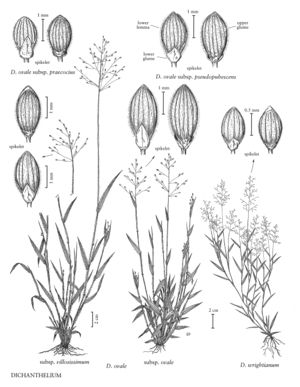Dichanthelium ovale subsp. praecocius
Basal blades 1-3 cm, sparsely to densely evenly pilose. Culms less than 1 mm thick, wiry; internodes with soft, spreading or retrorse papillose-based hairs longer than 4 mm. Cauline sheaths with soft, spreading or retrorse hairs, hairs usually longer than 4 mm, papillose-based; ligules 3-4 mm; blades 2-6 mm wide, both surfaces densely pilose. Spikelets 1.8-2.1 mm, obovoid or ellipsoid, pilose with papillose-based hairs.
Discussion
Dichanthelium ovale subsp. praecocius is most common in the midwest and in the tallgrass prairie states. It intergrades with subsp. villosissimum, especially in the western parts of the latter's range, and to a lesser extent, with D. acuminatum subsp. fasciculatum in the northern part of its range.
Selected References
None.
Lower Taxa
"usually distinctly longer and narrower" is not a number."decumbent" is not a number."wide" is not a number.
